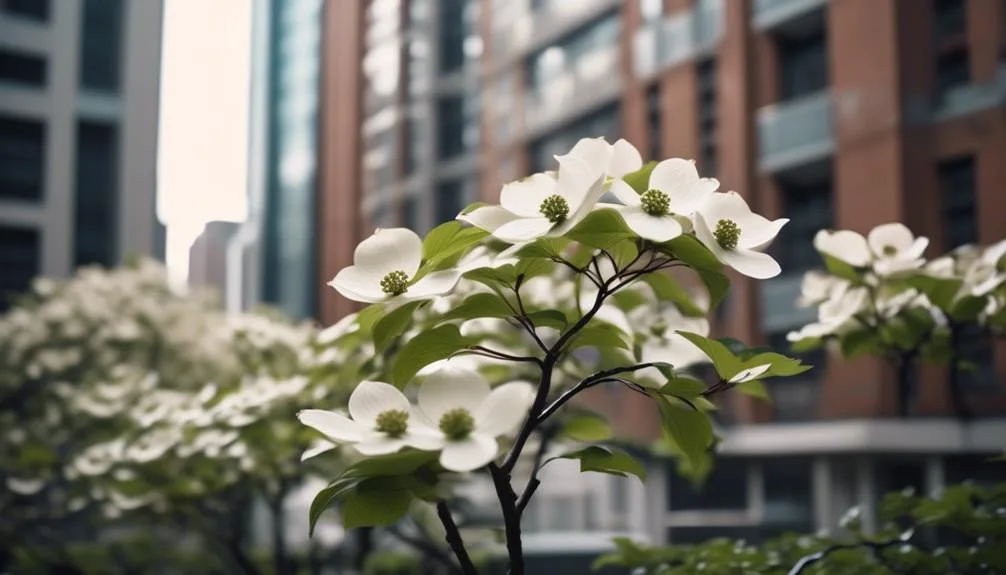Dogwood trees can actually thrive in urban areas. Understanding their needs and choosing the right varieties is key.
From suitable growing conditions to urban-friendly varieties, there's much to explore. Let's uncover the potential of growing dogwood trees in cities.
Suitable Urban Conditions for Dogwood Trees
In urban areas, dogwood trees thrive in well-drained soil and benefit from partial shade to protect them from the harsh sun and heat. When planting dogwood trees in urban settings, it's crucial to ensure the soil quality is optimal, as they prefer moist, well-drained soil.
Additionally, adequate spacing between trees is essential for their healthy growth and development. Dogwood trees also require sufficient sunlight exposure, but partial shade can help shield them from excessive heat and sun, especially in urban environments where pollution and heat can be more intense.
These trees exhibit a moderate tolerance to pollution, making them suitable for urban landscapes. By considering these factors, you can create a conducive environment for the successful growth of dogwood trees in urban settings.
Potential Challenges for Dogwood Trees in Urban Environments
Thriving in urban environments, dogwood trees may encounter various challenges that can affect their health and growth. These challenges include:
- Soil Quality: Urban soil often lacks proper nutrients and may be compacted, making it difficult for dogwood trees to access essential minerals and water.
- Pollution: Dogwood trees are sensitive to air and soil pollution, which can weaken their immune systems and hinder their growth.
- Root Space: Limited space for root expansion in urban settings can lead to stunted growth and decreased stability for dogwood trees.
- Competition: In urban environments, dogwood trees must compete with other plants and trees for resources, which can hinder their overall development.
Navigating these challenges is crucial for ensuring the successful growth of dogwood trees in urban environments.
Best Dogwood Tree Varieties for Urban Growth
When selecting dogwood tree varieties for urban growth, consider the compact and disease-resistant characteristics of the Stellar Pink and Cherokee Brave varieties. These varieties are ideal for urban planning due to their ability to thrive in urban environments.
The Stellar Pink dogwood is known for its compact size, making it suitable for smaller urban spaces. Its pink flowers and resistance to diseases make it a popular choice.
Similarly, the Cherokee Brave variety is valued for its resilience against anthracnose and powdery mildew, common issues in urban areas.
When planting these trees, ensure good soil quality and ample tree spacing to promote healthy growth. Proper tree selection is crucial for successful urban tree planting, and these varieties offer the beauty and resilience needed for urban settings.
Proper Care and Maintenance of Dogwood Trees in Urban Settings
To maintain the health and beauty of dogwood trees in urban settings, it's essential to adhere to a regular care and maintenance routine. Proper care ensures that the trees can thrive despite the challenges of urban environments. Here are some key points to consider:
- Pruning Techniques
- Regularly prune dead or diseased branches to promote healthy growth and maintain an attractive shape.
- Avoid aggressive pruning, especially in urban settings, as dogwood trees are sensitive to excessive trimming.
- Watering Schedule
- Provide consistent and deep watering, especially during dry periods, to keep the soil moist but not waterlogged.
- Mulch around the base of the tree to help retain moisture and regulate soil temperature.
Benefits of Growing Dogwood Trees in Urban Areas
Dogwood trees in urban settings not only require proper care and maintenance but also offer a range of benefits that enhance the urban environment. By growing dogwood trees in urban areas, you can positively impact the environment and community aesthetics. These trees provide shelter and food for urban wildlife, fostering biodiversity and creating a more vibrant ecosystem. Moreover, dogwood trees contribute to improving air quality by absorbing pollutants and releasing oxygen. The presence of these trees also enhances the visual appeal of urban landscapes, adding to the overall beauty of the community. Below is a table summarizing the benefits of growing dogwood trees in urban areas:
| Benefits | Description |
|---|---|
| Environmental Impact | Provides shelter and food for urban wildlife, fostering biodiversity |
| Community Aesthetics | Enhances the visual appeal of urban landscapes |
| Urban Wildlife, Air Quality | Improves air quality by absorbing pollutants and releasing oxygen |
Conclusion
Incorporating dogwood trees into urban settings is a worthwhile endeavor. With proper care, these trees can thrive in the city, offering beauty and benefits that outweigh any potential challenges.
So, go ahead, plant them and reap the rewards of having these beautiful trees in your urban environment.

My interest in trees started when I first saw the giant sequoias in Yosemite.
I was a teenager then, and I remember thinking, “I need to learn more about this.”
That moment stuck with me.
A few years later, I went on to study forestry at Michigan Tech.
Since graduating, I’ve worked in a mix of hands-on tree care and community education.
I’ve spent over ten years helping people understand how to plant, maintain, and protect the trees in their neighborhoods.
I don’t see trees as just part of the landscape.
They are living things that make a real difference in our daily lives.
